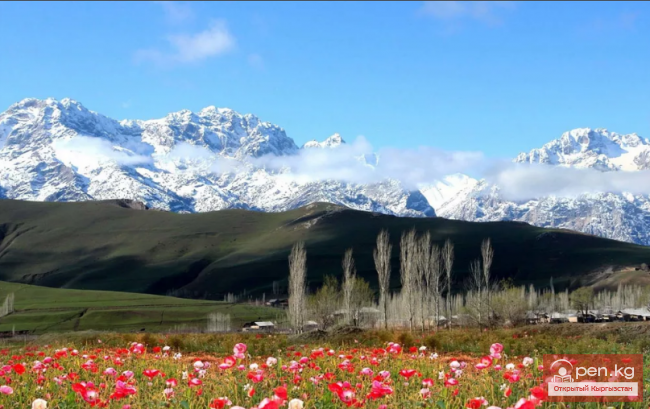
Let’s open the reference books on medicinal plants. St. John's wort, mint, thyme, valerian, motherwort, hawthorn, rosehip, coltsfoot, oregano, plantain, juniper, birch, cornflower, chamomile... This entire list is generously represented in Kyrgyzstan.
The vegetation of the forest-meadow-steppe zone is a true "green pharmacy." Here you can find valerian root that rivals the best Thuringian varieties. The blue gentian, a herbaceous plant with upright stems and small bright blue fragrant flowers with a bell-shaped corolla, has a calming effect eight to ten times stronger than that of valerian. Coltsfoot sometimes reaches the subalpine belt. Decoctions made from it are known to be used for lung and bronchial diseases. Marshmallow, sage, St. John's wort, rhubarb, succession, medicinal thyme — finding them on mountain slopes and in gorges is not difficult.
Among the medicinal herbs is thermopsis — a low plant, up to five centimeters tall, with a creeping rhizome and large yellow flowers. Decoctions of it are used for intestinal diseases. However, do not rush to pick it. Thermopsis often causes allergic reactions, which are accompanied by skin itching, swelling, and the appearance of rashes.
Particularly noteworthy is the Issyk-Kul root, distinguished by its bright purple flower. The root of this plant contains a potent poison, aconitine — deadly even in the smallest doses. Just holding it in a sweaty hand can lead to poisoning. The poison from the Issyk-Kul root is used in microdoses to prepare some medicines.
Another plant that deserves special attention, as it is found only in Kyrgyzstan, is the tangled larkspur. It grows up to one meter tall, has dark purple flowers, and later — small berries. It grows at altitudes of up to 3300 meters above sea level. Decoctions of larkspur are used for intestinal disorders and to increase the tone of motor muscles.
And, of course, everywhere in the meadow-forest zone grows the well-known mint. Its leaves and flowers contain oil that is widely used in the confectionery industry and in medicine. Housewives add it to tea, when preparing various dishes, and put it in pickles. In folk medicine, mint is widely used as a choleretic and pain-relieving agent, as well as for dilating the blood vessels of the heart and brain. A lot of mint oil is also found in oregano (ziziphora), which is used in medicine and perfumery.
An experienced tourist planning to go to the mountains of the republic in summer may not need to pack too many food supplies: nature has prepared much for them. For example, several types of "sour herbs," wild onions, and garlic. Or, for instance, thirty species of beautiful eremurus flowers — from pale pink to purple, the leaves of which, rich in vitamins, can be eaten like cabbage. (By the way, from the rhizomes of eremurus, a substance is obtained that allows for the production of ice cream that does not melt even in the sun.) There are also many mushrooms found in various zones — from semi-deserts to forests. It is worth noting that when collecting mushrooms, you should neither cut them nor pull them out. They should be carefully twisted out of the soil — in this way, you will not damage the mycelium and will not leave a stump that could become infected. Do not touch rotten and overripe mushrooms: if left in place, they will disperse spores that will yield a new harvest.
At the end of June — beginning of July, strawberries ripen on the grassy slopes and forest edges. If you collect them in the morning, after the dew has fallen, or in the late afternoon before the dew appears, they will last longer. Shortly thereafter, the berries of honeysuckle, black currant, barberry, raspberry, sea buckthorn, and dog rose begin to ripen. In the ravines along the banks of rivers and streams, blackberries grow, delicious in themselves, but also helpful for gastrointestinal diseases.
Sea buckthorn is perhaps found in no other part of the world in such quantities as in the Tien Shan. Its golden berries, somewhat reminiscent of pineapple in taste, densely cover the branches of the shrub, which are covered with sharp thorns. In terms of the vitamins they contain, these berries are unmatched. They can be made into jam, jelly, or juice, but it is best to mash them with sugar to preserve their natural taste and not destroy the vitamins. Sea buckthorn seeds are used to make oil, which is indispensable for treating burns, wounds, gastric ulcers, and other ailments.
Let’s also mention barberry, as it is not commonly found in other regions of the CIS. This is a spiny, highly branched shrub with red or purple berries with an elongated stone, ripening in September-October. The berries, with a pleasant sourness, are rich in vitamin C. They have been used for food since ancient times, as well as for thirst relief and as a medicinal remedy to stimulate appetite, reduce fever, and treat intestinal disorders. Barberry is used to make jelly, jam, and drinks, or it is simply dried. It is good to throw a handful of dried barberry into the cauldron when preparing pilaf.















































